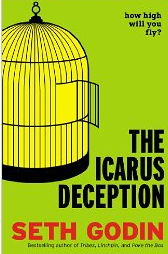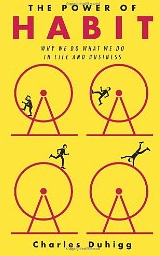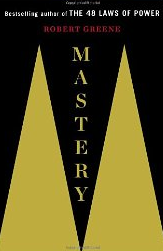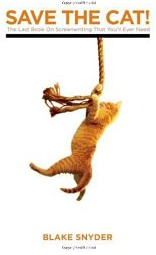I recently read The Icarus Deception by Seth Godin. Below are the quotes I found most interesting. As always, if you like the quotes, please buy the book here.
 “Competence is no longer scarce. We have too many good choices – there’s an abundance of things to buy and people to hire. What’s scarce is trust, connection and surprise. There are three elements in the work of a successful artist.” (10)
“Competence is no longer scarce. We have too many good choices – there’s an abundance of things to buy and people to hire. What’s scarce is trust, connection and surprise. There are three elements in the work of a successful artist.” (10)
“If your factory burns down but you have loyal customers, you’ll be fine. On the other hand, if you lose your customers, even your factory isn’t going to help you – Detroit is filled with empty factories.” (13)
“If your team is filled with people who work for the company, you’ll soon be defeated by tribes of people who work for a cause.” (13)
“In the words of Joseph Campbell, you’re doing art “for the experience of being alive.”” (17)
“Sometimes, courage is the willingness to speak the truth about what you see and to own what you say.” (17)
“The industrialist needs you to dream about security and the benefits of compliance. The industrialist works to sell you on a cycle of consumption (which requires more compliance). And the industrialist benefits from our dream of moving up the corporate ladder, his ladder.” (27)
“Industrialization is about eliminating the risk of failure, about maintaining the status quo, and about cementing power. “Too big to fail” is the goal of every industrialist, but “too big to fail” means that capitalism is no longer functioning.” (27)
“After nearly a century of effort, the industrial system has created the worker-proof factory.” (28)
“College started as a community of masters and scholars. It was a refuge; it was a place you went to get lost in ideas, to discover and wander, and to plot a course as an academic. Today it’s a place you go to exchange a lifetime of debt for credit hours, a degree, and maybe a good job.” (33)
“The search for the right answer is the enemy of art. the right answer belongs to the productivity-minded industrialists.” (36)
“Art has no right answer. The best we can hope for is an interesting answer.” (36)
“Creating art is a habit, one that we practice daily or hourly until we get good at it.” (38)
“If you ask someone for the rule book on how to lead, you’re secretly wishing to be a manager.” (40)
“Our cultural instinct is to wait to get picked. To seek out the permission, authority, and safety that come from a publisher or a talk-show host or even a blogger who says, “I pick you.” Once you reject that impulse and realize that no one is going to select you – that Prince Charming has chosen another house in his search for Cinderella – then you can actually get to work.” (48)
“Once you understand that there are problems waiting to be solved, once you realize that you have all the tools and all the permission you need, then opportunities to contribute abound.” (49)
“Precisely because they didn’t fit in, they had little choice but to pick themselves. And once that choice is made, it becomes a habit.” (54)
“We have big-box stores and big-box storage units and big-box debt. But we’re still lonely. And we’re still bored.” (59)
“In order to efficiently jam as much testable data into each generation of kids, we push to make those children compliant, competitive zombies.” (62)
“The risk isn’t the risk of financial ruin (though that might be part of it). No, the risk is the risk of rejection. Of puzzlement. Of stasis.” (64)
“When you expect applause, when you do your work in order to get (and because of) applause, you have sold yourself short. When your work depends on something out of your control, you have given away part of your art. If your work is filled with the hope and longing for applause, it’s no longer your work – the dependence on approval in this moment has corrupted it, turned it into a process in which you are striving for ever more approval.” (71)
“We don’t blame the nail for breaking the hammer or blame the water for leaking from the pot. If the audience doesn’t like this work enough to connect, there’s a mismatch.” (71)
“One definition of propaganda: it benefits the teller, not the recipient.” (76)
“Six Daily Habits for Artists:
Sit alone; sit quietly.
Learn something new without any apparent practical benefit.
Ask individuals for bold feedback; ignore what you hear from the crowd.
Spend time encouraging other artists.
Teach, with the intent of making change.
Ship something that you created.” (82)
“When your art fails, make better art.” (91)
“When the venue doesn’t support your art, you can change it without changing your commitment ot the journey.” (92)
“It’s precisely the high-wire act of “this might not work” that makes original art worth doing.” (93)
“We make the art and then we get the feedback, but the art must happen first. If we’re in love with the feedback and trying to manipulate the applause we get, we’ll cease to make the art we’re capable of.” (94)
“Art is a commitment to a process and to a direction and to generosity, not to a result.” (95)
“Some people will persevere merely because they are instructed to do so. Those with grit will persevere because they believe they have no choice, not if they wish to be who they are.” (111)
“If the grind is wearing you down, then you may be viewing the grind as the enemy, something apart from the work itself. The person with grit, on the other hand, understands that the grind is part of the work, that the grind is part of what makes the work interesting, a challenge, worth doing. If there was no grind, you’d need no grit.” (111)
“People with grit consciously set long term goals that are difficult to attain and do not waver from these difficult goals, regardless of the presence of feedback.” (112)
“What you are engrossed in isn’t nearly as important as the fact of being engrossed.” (112)
“Blaming the system is soothing because it lets you off the hook. But when the system is broken, we wonder why you were relying on the system in the first place.” (116)
“If not enough people doubt you, you’re not making a difference.” (118)
“I haven’t sought out and read a review or a tweet since. This is not cowardice; it’s the act of someone who wants to keep writing and is determined to do it for an audience of his choosing.’ (127)
“First you must pick yourself, and then you choose your audience.” (127)
“The masses (by definition) aren’t pleased by the new; they are pleased by what others think.” (128)
“An unheard symphony isn’t a symphony; it is notes on paper. Art doesn’t become art until it meets an audience. Your goal as artist is to make art that moves the audience of your choice.” (128)
“Four common mistakes that help you hide:
Busy is the same as brave.
A mentor is going to change your life.
Waiting to get picked is the next step.
There is a secret, and you will soon learn it.” (132)
“The resistance is a symptom that you’re on the right track. The resistance is not something to be avoided; it’s something to seek out.” (136)
“The artist seeks out the feeling of the resistance and then tries to maximize it. The cog, the day laborer, the compliant student – they seek to eliminate the feeling instead.” (136)
“Your effort is rarely correlated with how much the audience cares.” (139)
“A big enough audience will destroy you.” (141)
“The dangerous addiction is to keep expanding the audience until we find people who hate our work.” (141)
“The ability to see the market and the technology and the talent as it is, instead of how you want it to be (or fear it to be), is one of the secret skills of the successful creator.” (145)
“When you’re wrong, the instinct is to blame the universe, not your worldview.” (146)
“You can’t accurately see until you abandon your worldview.” (147)
“Only when you make art that isn’t for everyone do you have a chance to connect with someone. And when you connect with someone, amazingly, you increase the chances that you’ve made something that many will want.” (159)
“If you’re not achieving the results you seek, your definition of good might be wrong, or your art might not be as good as you think it is. Or you might not have gotten lucky this time around.” (160)
“Pick which rules to break, and embrace the rest.” (173)
“Jason Fox says, “The art of compromise is knowing when not to.” To put it another way, “It’s best to get as many people as possible into one room. And then go somewhere else.” (173)
“The industrial economy won’t disappear, but the agenda will increasingly be set by those who make connection, not widgets.” (175)
“Ira Glass understands how you feel:
Nobody tells this to people who are beginners, I wish someone told me. All of us who do creative work, we get into it because we have good taste. But there is this gap. For the first couple years you make stuff, it’s just not that good. It’s trying to be good, it has potential, but it’s not. But your taste, the thing that got you into the game, is still killer. And your taste is why your work disappoints you. A lot of people never get past this phase, they quit. Most people I know who do interesting, creative work went through years of this. We know our work doesn’t have this special thing that we want it to have… And if you are just starting out or you are still in this phase, you gotta know it’s normal and the most important thing you can do is do a lot of work… it is only by going through a volume of work that you will close that gap, and your work will be as good as your ambitions.” (176)
“An unsolvable problem is almost as good as a solved one. An unsolvable problem means that you can declare defeat and move on. It means you can eliminate this excuse from your almanac of excuses, because your goal is unrealistic.” (181)
“The only way to be vulnerable and go to the edge is to realize that if your art doesn’t work, you’ll be back tomorrow with more (better) art.” (187)
“Habits of successful artists:
Learn to sell what you’ve made.
Say thank you in writing.
Speak in public.
Fail often.
See the world as it is.
Make predictions.
Teach others.
Write daily.
Connect others.
Lead a tribe.” (194)
“Every time you work with someone who makes your work less than it ought to be, you’ve made a choice and you’ll need to live with the consequences. It’s also worth noting how cheap it is to build a portfolio of just about any sort of work now, and you hide your most daring work at your own peril.” (197)
“David Putnam, exiled Hollywood chieftain, is credited with this law: “It is more acceptable to fail in conventional ways than in unconventional ways. And its corollary: The reward for succeeding in unconventional ways is less than the risk of failing in unconventional ways. In short, you can screw up with impunity so long as you screw up like everybody else.” (203)
“When we see the “work” we do as part of a game, with moves instead of failures, with outcomes instead of tragedies, we’re more likely to bring the right spirit to our work. Whatever happens is part of the game – that’s why we’re playing it.” (204)
“My new favorite word in German is funktionslust. It describes the love of doing something merely for the sake of doing it, not simply because it’s likely to work.” (209)
“Artists play. We don’t analyze our return on investment or seek shortcuts. We are playing, not working, and the long way is often the best way to get to where we’re going, because sometimes we’re not going anywhere.” (209)
“Art almost never works as fast as you want it to, and the more you need it to work, the slower it happens.” (211)
“The successes are about the privilege of doing more work, not about winning.” (215)
“Pain is the truth of art. Art is not a hobby or a past time. It is the result of an internal battle royal, one between the quest for safety and the desire to matter.” (237)
“Quality, like feedback, is a trap. To focus on reliably meeting specifications (a fine definition of quality) is to surrender the real work, which is to matter. Quality of performance is a given; it’s not the point.” (237)
If you liked the quotes, please buy the book here.





